Despite the competition from the contemporary Freeze Seoul fair, The Armory Show was successfully held in New York: 225 international galleries from more than 35 countries, with works by over 800 artists, and with a substantial presence of Italian galleries. The Platform section was interesting, curated by Eva Respini, which crossed the entire exhibition space with a series of large works. Worthy of note was the Focus section, curated by Candice Hopkins, in which the artists used particular materials, protocols of involvement that go beyond simple vision: some works produced sound and were activated through performance, while others were based on body rhythms, still others incorporated jingles and hymns. Finally, the Presences, Solo, (with galleries no more than ten years old) and Galleries sections.
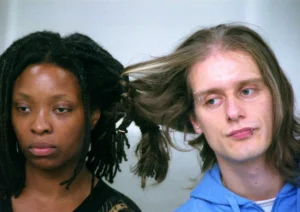
Sonia Boyce, Exquisite Tension, 2005, 1 monitor video TRT: 4 minutes. Monitor dimensions variable Photographic print: 70 x 99 x 1.5 cm (27 1/2 x 39 x 5/8 in.). Edition 2 of 5 + 1 AP, photo: Sonia Boyce, courtesy Apalazzogallery, Brescia
Coming to the Italian galleries, as soon as you enter, on the left side, Apalazzogallery presented three works by Sonia Boyce. The artist was born in London, UK, in 1962, and her work focuses on issues of race, gender and intimacy, and the complex relationships between ethnicity and difference. She is a leading figure in the British Black Movement, now also in the Hauser & Wirth group; moreover, in 2022, at the 59th Venice Biennale, her work Feeling Her Way was awarded the Golden Lion. One of her subjects is hair, which is to be understood as significant, and in particular afro-textured hair, which allows her to explore the sense of otherness, often associated with the body of African descent. The three works on display span twenty-five years of activity. The new Braided wallpaper, 2023, was created to form a dialogue between the other two works Exquisite Tension, 2005 and The Audition in Colour, 1997/2020, with seventy-five photographic prints taken from the Fuji Crystal archive and mounted on aluminum. We can define the project as “open” because it starts with an open invitation to participants to try on an Afro wig and then be photographed with and without a wig.
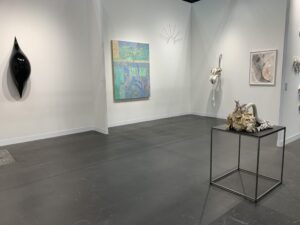
Galleria Massimo Minini and Francesca Minini, The Armory Show, 2023, installation view, photo Emanuele Magri for Juliet
Francesca Minini (Milan) was at The Armory Show 2023 in a stand shared with the Galleria Massimo Minini and exhibited beautiful works by Carla Accardi, such as Assonanza verisimile from 2011. Then we found works by Ivana Basic, Sol Calero, Sheila Hicks, Landon Metz, Alice Ronchi, Francesco Simeti. Vistamare (Milan/Pescara) brought big names such as Charles Avery, Rosa Barba (with Libertà, 2020), Claudia Comte (with Gira e scivola 110, 2022) and works by Anna Franceschini, Mimmo Jodice, Camille Henrot, Maria Loboda, Goshka Macuga , Eileen Quinlan, Ettore Spalletti, Haim Steinbach. P420 (Bologna) presented the work of its artists Helene Appel, Irma Blank, Scritti radicali, poesia per Marina Cvetaeva from 1994, Adelaide Cioni, Pezzo di cielo from 2021, Mairead O’hEocha, Francis Offman, Stephen Rosenthal, Pieter Vermeersch and Shafei Xia. In the Solo section, Galleria Alberta Pane, at stand S16, exhibited a unique showcase of artworks by Marcos Lutyens. A series of paintings, drawings, ceramics and on the floor a circle of broken ceramics, accessible in augmented reality, which invited visitors to relive the world in an intensified way.
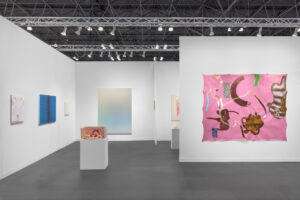
P420, The Armory Show, New York, 2023, installation view, photo Sebastiano Pellion di Persano, courtesy P420, Bologna
Luce Gallery from Turin proposed Dominic Chambers, Yowshien Kuo, Collins Obijiaku, Zéh Palito and Ludovic Nkoth, an artist who will exhibit in Paris in October and about whom we write in Juliet in the October 2023 issue and to whom the upcoming issue will also dedicate the cover. Lorcan O’Neill from Rome exhibited Tracey Emin, Giorgio Griffa, Matvey, Levenstein, Kiki Smith, Rachel Whiteread. The Secci Gallery presented some beautiful and challenging sculptures by Giò Pomodoro. Poggiali played it safe with Claudio Parmiggiani and Erwin Wurm. The Victoria Miro Gallery (with offices in London and Venice) exhibited the New York painter María Berrío, managing to sell all the new works in the morning with prices between 65 thousand and 200 thousand dollars. Among its neighbors, the Repetto Gallery from Lugano, London, brought beautiful works by Salvo, Carla Accardi, Alighiero Boetti, Luigi Boille, Piero Dorazio, Lucio Fontana, Fausto Melotti, Alessandro Piangiamore, Michelangelo Pistoletto, Mimmo Rotella, Arcangelo Sassolino, Mario Schifano. The Nature Morte Gallery in New Delhi featured magnificent fabric works by Ayesha Singh and Sagarica Sundaram (Iris, 2023): sculptural installations on the socio-political power hierarchies inherent in architecture through research on her hometown. We found them again in works such as Lady Zercin, 2019, This Pebble, 2022, by Sermin Kardestuncer from Pierogi Gallery in New York (color photography, cotton fabric, thread, white pencil, wood).

Bockley Gallery, The Armory Show, New York, 2023, installation view, photo Emanuele Magri for Juliet
Bockley Gallery featured Eric-Paul Riege, a member of Tachii’nii’s Charcoal Streaked Division, with suspended fiber works, creating dancing shadows, soft muslin sculptures, blended fabrics, polyester batting, faux fur and synthetic hair, and real as well as sheep’s wool and yarn and metal cones (see jaatłoh4Ye’iitsoh). At CLEARING (New York, Brussels, Los Angeles) we found a very curious work by Sara Flores, an author belonging to the Shipibo-Conibo nation, an indigenous people which live along the Ucayali river in the Peruvian Amazon: in the creation of this work she used the pigments of the native Peruvian flora to create hand-drawn patterns on cotton fabrics. Whatiftheworld Gallery in Capetown presented Dan Halter (born in Zimbabwe in 1977 and currently living in South Africa), who weaves hand-woven archival inkjet-printed texts using artisanal methods and everyday materials. The Smac Gallery, also from Capetown, brought Mary Sibande’s extraordinary masks (sculpture, textiles, photography) which refer to the concept of power over the black female body in post-apartheid South Africa. Starting from her family’s domestic work and her sculptural alter ego, she dresses in bright clothes such as domestic workers’ uniforms or Victorian dresses, playing on the contrast between poor and rich.
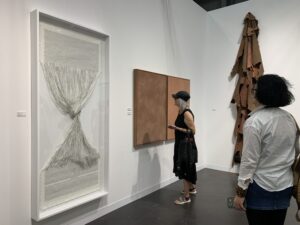
Whatiftheworld Gallery, Capetown, The Armory Show, New York, 2023, installation view, installation view, photo Emanuele Magri for Juliet
The KO Gallery in Lagos, unique in Black Africa, specializing in supporting Nigerian artists presented Modupeola Fadugba with Buon Go Round in gold from 2022. The FAZAKAS Gallery, in Vancouver, founded in 2012 to create an exhibition space for the promotion of contemporary indigenous art, exhibited Beau Dick’s masks (Donna lontra, 2012), about which the gallery’s director, LaTiesha Fazakas, directed a documentary film.
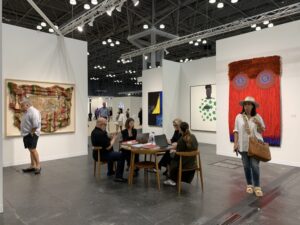
Robert Project, Los Angeles, The Armory Show, New York, 2023, installation view, installation view, photo Emanuele Magri for Juliet
At Robert Project (Los Angeles) we found the beautiful work The Awakening (2023) by Suchitra Mattai working with worn vintage saris, vintage tapestries, embroidery thread, beads, appliques, tassels and cords using painting, drawing, sculpture, video on Indo-Caribbean heritage. Among the various works from the Ron Mandos Gallery in Amsterdam, the carpet by Marcos Kueh Homo Savagius Obedius (II selvaggio colto, 2023) dominated the center of the stand. In short, in this Armory Show New York 2023 there may not have been many mega galleries, but there was certainly a lot of research, many proposals and an infinite number of exquisite works. And then, let’s be honest: New York is always New York.
Emanuele Magri
Info:
thearmoryshow.com/news/2023-sections

Emanuele Magri teaches History of Art in Milan. Since 2007 he has been writing abroad for Juliet art Magazine. Since the 1970s he has dealt with writing and visual arts. He created taxonomically defined worlds, in which he experimented with the self-referentiality of language, such as “La Setta delle S’arte” in which ritual clothes are made starting from words with multiple meanings, the “Treaty of genetic art” in which a series of plants is obtained from grafts of human organs, eyes, hands, mouths, etc., and the project “Fandonia”, a city where everything is double and hybrid.



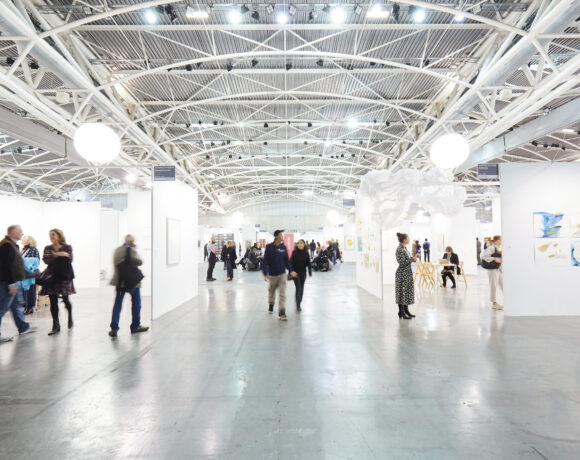
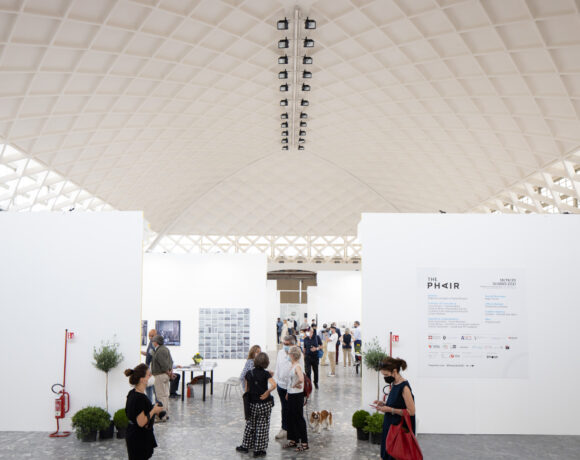

NO COMMENT